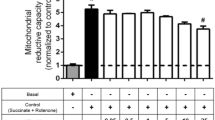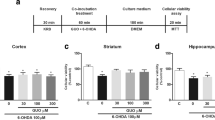Abstract
It is reported that tramadol can induce neurotoxic effects with the production of DNA damage, mitochondrial dysfunction, and oxidative stress. The current study aimed to evaluate the potential role of mitochondrial impairment in the pathogenesis of tramadol-induced neurotoxicity, and protective effect of sinapic acid (SA) against it in isolated mitochondria from rat brain. Mitochondria were isolated and were incubated with toxic concentrations (100 μM) of tramadol and then cotreated with tramadol + SA (10, 50, and 100 μM). Biomarkers of mitochondrial toxicity including succinate dehydrogenases (SDH) activity, reactive oxygen species (ROS), lipid peroxidation (LPO), mitochondrial membrane potential (MMP), GSH depletion, and mitochondrial swelling were assessed. Our results showed a significant decrease in SDH activity, and a significant increase in ROS, LPO, GSH depletion, MMP collapse, and mitochondrial swelling was detected in tramadol group. We observed that 50 and 100 μM SA cotreatment for 1 h efficiently ameliorated tramadol-caused damage in mitochondrial dysfunction, accumulation of ROS, LPO, GSH depletion, depolarization of mitochondrial membrane potential, and mitochondrial swelling. These data suggest that mitochondrial impairment and oxidative stress are mechanisms involved in the pathogenesis of tramadol-induced neurotoxicity. Also, results indicate that SA antagonizes against tramadol-induced mitochondrial toxicity and suggest SA may be a preventive/therapeutic agent for tramadol-induced neurotoxicity complications.





Similar content being viewed by others
Data availability
The datasets generated during and/or analyzed during this study are available from the corresponding author on reasonable request.
References
Ahmed AI, El-Dawy K, Fawzy MM, Abdallah HA, Elsaid H, Elmesslamy WO (2018) Retrospective review of tramadol abuse. Slov Vet Res 55:471–483
Akbar M, Essa MM, Daradkeh G, Abdelmegeed MA, Choi Y, Mahmood L, Song B-J (2016) Mitochondrial dysfunction and cell death in neurodegenerative diseases through nitroxidative stress. Brain Res 1637:34–55
Ali HA, Afifi M, Saber TM, Makki AA, Keshta A, Baeshen M, Al-Farga A (2020) Neurotoxic, hepatotoxic and nephrotoxic effects of tramadol administration in rats. J Mol Neurosci 70:1934–1942
Awadalla EA, Salah-Eldin A-E (2016) Molecular and histological changes in cerebral cortex and lung tissues under the effect of tramadol treatment. Biomed Pharmacother 82:269–280
Bernardini S, Tiezzi A, Laghezza Masci V, Ovidi E (2018) Natural products for human health: an historical overview of the drug discovery approaches. Nat Prod Res 32:1926–1950
Bradford MM (1976) A rapid and sensitive method for the quantitation of microgram quantities of protein utilizing the principle of protein-dye binding. Anal Biochem 72:248–254
da Silva DD, Silva JP, Carmo H, Carvalho F (2021) Neurotoxicity of psychoactive substances: a mechanistic overview. Curr Opin Toxicol 28:76–83
Edinoff AN, Kaplan LA, Khan S, Petersen M, Sauce E, Causey CD, Cornett EM, Imani F, Moghadam OM, Kaye AM (2021) Full opioid agonists and tramadol: pharmacological and clinical considerations. Anesthesiol Pain Med 11:e119156
Faria J, Barbosa J, Moreira R, Queirós O, Carvalho F, Dinis-Oliveira R (2018) Comparative pharmacology and toxicology of tramadol and tapentadol. Eur J Pain 22:827–844
Firuzi O, Giansanti L, Vento R, Seibert C, Petrucci R, Marrosu G, Agostino R, Saso L (2003) Hypochlorite scavenging activity of hydroxycinnamic acids evaluated by a rapid microplate method based on the measurement of chloramines. J Pharm Pharmacol 55:1021–1027
Ghoneim FM, Khalaf HA, Elsamanoudy AZ, Helaly AN (2014) Effect of chronic usage of tramadol on motor cerebral cortex and testicular tissues of adult male albino rats and the effect of its withdrawal: histological, immunohistochemical and biochemical study. Int J Clin Exp Pathol 7:7323
Golpich M, Amini E, Mohamed Z, Azman Ali R, Mohamed Ibrahim N, Ahmadiani A (2017) Mitochondrial dysfunction and biogenesis in neurodegenerative diseases: pathogenesis and treatment. CNS Neurosci Ther 23:5–22
Iglesias-González J, Sánchez-Iglesias S, Beiras-Iglesias A, Soto-Otero R, Méndez-Álvarez E (2013) A simple method for isolating rat brain mitochondria with high metabolic activity: effects of EDTA and EGTA. J Neurosci Methods 213:39–42
Iorfa SK, Ifeagwazi CM, Effiong JE, Essien NF (2019) Tramadol abuse and value for life among young persons: moderating effects of moral identity. Afr J Drug Alcohol Stud 18:109–120
Kalantari H, Jalali M, Jalali A, Mahdavinia M, Salimi A, Juhasz B, Tosaki A, Gesztelyi R (2011) Protective effect of Cassia fistula fruit extract against bromobenzene-induced liver injury in mice. Hum Exp Toxicol 30:1039–1044
Khezri S, Sabzalipour T, Jahedsani A, Azizian S, Atashbar S, Salimi A (2020) Chrysin ameliorates aluminum phosphide-induced oxidative stress and mitochondrial damages in rat cardiomyocytes and isolated mitochondria. Environ Toxicol 35:1114–1124
Kim DH, Yoon BH, Jung WY, Kim JM, Park SJ, Park DH, Huh Y, Park C, Cheong JH, Lee K-T (2010) Sinapic acid attenuates kainic acid-induced hippocampal neuronal damage in mice. Neuropharmacology 59:20–30
Lee S-B, Yang HO (2022) Sinapic acid ameliorates REV-ERB α modulated mitochondrial fission against MPTP-induced Parkinson’s disease model. Biomol Ther 30:409–417
Lee HE, Kim DH, Park SJ, Kim JM, Lee YW, Jung JM, Lee CH, Hong JG, Liu X, Cai M (2012) Neuroprotective effect of sinapic acid in a mouse model of amyloid β1–42 protein-induced Alzheimer’s disease. Pharmacol Biochem Behav 103:260–266
Lee-Manion AM, Price RK, Strain J, Dimberg LH, Sunnerheim K, Welch RW (2009) In vitro antioxidant activity and antigenotoxic effects of avenanthramides and related compounds. J Agric Food Chem 57:10619–10624
Markaki M, Tavernarakis N (2020) Mitochondrial turnover and homeostasis in ageing and neurodegeneration. FEBS Lett 594:2370–2379
Mehdizadeh H, Pourahmad J, Taghizadeh G, Vousooghi N, Yoonessi A, Naserzadeh P, Behzadfar L, Rouini MR, Sharifzadeh M (2017) Mitochondrial impairments contribute to spatial learning and memory dysfunction induced by chronic tramadol administration in rat: protective effect of physical exercise. Prog Neuropsychopharmacol Biol Psychiatry 79:426–433
Miotto K, Cho AK, Khalil MA, Blanco K, Sasaki JD, Rawson R (2017) Trends in tramadol: pharmacology, metabolism, and misuse. Anesth Analg 124:44–51
Mohamed TM, Ghaffar HMA, El Husseiny RM (2015) Effects of tramadol, clonazepam, and their combination on brain mitochondrial complexes. Toxicol Ind Health 31:1325–1333
Mohammadnejad L, Soltaninejad K (2022) Tramadol-induced organ toxicity via oxidative stress: a review study. Int J Med Toxicol Forensic Med 12:35430
Mohammadnejad L, Soltaninejad K, Seyedabadi M, Ghasem Pouri SK, Shokrzadeh M, Mohammadi H (2021) Evaluation of mitochondrial dysfunction due to oxidative stress in therapeutic, toxic and lethal concentrations of tramadol. Toxicol Res 10:1162–1170
Mousavi K, Manthari RK, Najibi A, Jia Z, Ommati MM, Heidari R (2021) Mitochondrial dysfunction and oxidative stress are involved in the mechanism of tramadol-induced renal injury. Curr Res Pharmacol Drug Disc 2:100049
Nakhaee S, Hoyte C, Dart RC, Askari M, Lamarine RJ, Mehrpour O (2021) A review on tramadol toxicity: mechanism of action, clinical presentation, and treatment. Forensic Toxicol 39:293–310
Nićiforović N, Abramovič H (2014) Sinapic acid and its derivatives: natural sources and bioactivity. Compr Rev Food Sci Food Saf 13:34–51
Pandi A, Kalappan VM (2021) Pharmacological and therapeutic applications of Sinapic acid—an updated review. Mol Biol Rep 48:3733–3745
Salami A, Seydi E, Pourahmad J (2013) Use of nutraceuticals for prevention and treatment of cancer. Iran J Pharm Res: IJPR 12:219
Samadi M, Shaki F, Bameri B, Fallah M, Ahangar N, Mohammadi H (2021) Caffeine attenuates seizure and brain mitochondrial disruption induced by Tramadol: the role of adenosinergic pathway. Drug Chem Toxicol 44:613–619
Schmedes A, Hølmer G (1989) A new thiobarbituric acid (TBA) method for determining free malondialdehyde (MDA) and hydroperoxides selectively as a measure of lipid peroxidation. J Am Oil Chem Soc 66:813–817
Shadnia S, Soltaninejad K, Heydari K, Sasanian G, Abdollahi M (2008) Tramadol intoxication: a review of 114 cases. Hum Exp Toxicol 27:201–205
Shirmard LR, Shabani M, Moghadam AA, Zamani N, Ghanbari H, Salimi A (2022) Protective effect of curcumin, chrysin and thymoquinone injection on trastuzumab-induced cardiotoxicity via mitochondrial protection. Cardiovasc Toxicol 22:663–675
Silambarasan T, Manivannan J, Krishna Priya M, Suganya N, Chatterjee S, Raja B (2014) Sinapic acid prevents hypertension and cardiovascular remodeling in pharmacological model of nitric oxide inhibited rats. PLoS ONE 9:e115682
Subedi M, Bajaj S, Kumar MS, Mayur Y (2019) An overview of tramadol and its usage in pain management and future perspective. Biomed Pharmacother 111:443–451
Teixeira J, Gaspar A, Garrido EM, Garrido J, Borges F (2013) Hydroxycinnamic acid antioxidants: an electrochemical overview. BioMed Res Int 2013
Vazzana M, Andreani T, Fangueiro J, Faggio C, Silva C, Santini A, Garcia M, Silva A, Souto E (2015) Tramadol hydrochloride: pharmacokinetics, pharmacodynamics, adverse side effects, co-administration of drugs and new drug delivery systems. Biomed Pharmacother 70:234–238
Wilkins HM, Troutwine BR, Menta BW, Manley SJ, Strope TA, Lysaker CR, Swerdlow RH (2022) Mitochondrial membrane potential influences amyloid-β protein precursor localization and amyloid-β secretion. J Alzheimers Dis: JAD 85:381–394
Yoon BH, Jung JW, Lee J-J, Cho Y-W, Jang C-G, Jin C, Oh TH, Ryu JH (2007) Anxiolytic-like effects of sinapic acid in mice. Life Sci 81:234–240
Zare K, Eidi A, Roghani M, Rohani AH (2015) The neuroprotective potential of sinapic acid in the 6-hydroxydopamine-induced hemi-parkinsonian rat. Metab Brain Dis 30:205–213
Zou Y, Kim AR, Kim JE, Choi JS, Chung HY (2002) Peroxynitrite scavenging activity of sinapic acid (3, 5-dimethoxy-4-hydroxycinnamic acid) isolated from Brassica juncea. J Agric Food Chem 50:5884–5890
Funding
This study was supported by Ardabil of Medical Sciences, Deputy of Research (approval code: IR.ARUMS.AEC.1401.014).
Author information
Authors and Affiliations
Contributions
AS conceived and designed research, analyzed data, and wrote the manuscript. MS, ZJ, AN, and SK conducted experiments. All authors read and approved the manuscript. The authors declare that all data were generated in-house and that no paper mill was used.
Corresponding author
Ethics declarations
Ethical approval
The Ethics Committee of the Ardabil University of Medical Sciences reviewed and approved the protocols for used animal in the current study (Code: IR.ARUMS.AEC.1401.014).
Competing interests
The authors declare no competing interests.
Additional information
Publisher's note
Springer Nature remains neutral with regard to jurisdictional claims in published maps and institutional affiliations.
Supplementary information
Below is the link to the electronic supplementary material.
Rights and permissions
Springer Nature or its licensor (e.g. a society or other partner) holds exclusive rights to this article under a publishing agreement with the author(s) or other rightsholder(s); author self-archiving of the accepted manuscript version of this article is solely governed by the terms of such publishing agreement and applicable law.
About this article
Cite this article
Shabani, M., Jamali, Z., Naserian, A. et al. Maintenance of mitochondrial function by sinapic acid protects against tramadol-induced toxicity in isolated mitochondria obtained from rat brain. Naunyn-Schmiedeberg's Arch Pharmacol 397, 889–897 (2024). https://doi.org/10.1007/s00210-023-02648-6
Received:
Accepted:
Published:
Issue Date:
DOI: https://doi.org/10.1007/s00210-023-02648-6




